Price compression and mileage running
/I like to use the term "price compression" to refer to the interaction of two benefits to travel hacking:
- The out-of-pocket price paid for travel is lower;
- The difference between the out-of-pocket price paid for more-expensive and less-expensive travel shrinks, even if the ratio between them stays the same.
The ideal cases are more-convenient or more-luxurious award redemptions that cost the same fixed number of miles and points, but you also see price compression when redeeming cheaply-acquired, fixed-value Ultimate Rewards, Membership Rewards, or ThankYou points: more expensive flights will cost more points, but the out-of-pocket expense of acquiring those points will be (in some cases much) closer than the cash prices.
Theory of mileage running
A traditional mileage run is a flight taken exclusively to earn airline miles, and will ideally cost less than 4 cents per mile flown if credited to a distance-based frequent flyer program. Personally, I understand the logic behind the traditional 4-cent-per-mile cap in the following way:
- a high-level elite will earn at least 2 redeemable miles per mile flown due to elite mileage bonuses;
- a travel hacker will attempt to redeem miles for at least 2 cents each;
- so by pre-paying for future, non-elite-qualifying travel through mileage runs, the mileage runner receives elite-qualifying miles in the present, which help them maintain high-level status and the perks that go with it.
Of course it's possible to mileage run speculatively or purposefully: someone can take every sub-4-cent flight available with the goal of earning the highest elite status possible, or they can take one or two mileage runs in order to top off an award or earn the last few elite-qualifying miles needed to reach the next level of elite status.
Price compression and mileage running
Looking at mileage runs through the lens of price compression results in some interesting conclusions.
In programs like Alaska Airlines Mileage Plan and American AAdvantage, which still feature distance-based redeemable-mile earning, price compression has no effect (besides making mileage runs cheaper): since booking more expensive flights (within a cabin of service) doesn't yield any additional redeemable or elite-qualifying miles, the goal of minimizing the cent-per-mile cost of each mileage run is still paramount. Reservations in excess of the 4-cent-per-mile "breakeven" point may still be worth making, but more expensive flights would have to be justified by an unusually high value placed on elite-qualifying miles — perhaps if you're a single flight away from the next elite status level.
In revenue-based programs where mileage earning is based strictly on the amount paid for tickets (although with a multiplier for elites in the case of Delta and United), it's only ever worth mileage running for the benefits of elite status (for example, free award changes and redeposits). In such programs, since more-expensive flights also earn more redeemable miles, part of the increased price is rebated in the form of more redeemable miles earned.
Consider the following stylized case: a United Premier 1K with the American Express EveryDay Preferred and Business Platinum combination wants to maintain her top-tier elite status with United. She manufactures spend at gas stations at roughly 1 cent per dollar in manufactured spend, and is able to redeem her Membership Rewards points for 4.29 cents on United flights after her 30% Pay with Points rebate. In other words, she is able to buy United tickets at a roughly 77% discount. As a MileagePlus Premier 1K, she earns 11 miles per dollar spent on United fares. Valuing each United mile at 2 cents each, as above, she's receiving a 22% discount on (the fare component) of each United revenue ticket she buys, meaning her net cost is just 1% of the fare, plus taxes and fees, which don't earn redeemable miles.
Let me be clear: this result only holds for someone who actually values the benefits of elite status, and is sure they'll redeem each one of their United miles for at least 2 cents (remember, unredeemed miles and points are worth nothing). But for someone positioned in this way, the cent-per-mile calculus is almost irrelevant, given the up-front discount and redeemable-mile rebate they receive on each revenue ticket they buy.
Conclusion
I don't fly United or credit my paid Delta flights to Delta, and I don't hold any super-premium credit cards since I don't find their annual fees worth paying. Still, I wanted to share this analysis to demonstrate the power of price compression when applied to a range of everyday problems in travel hacking.


